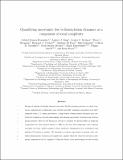Files in this item
Quantifying uncertainty due to fission–fusion dynamics as a component of social complexity
Item metadata
| dc.contributor.author | Ramos-Fernandez, Gabriel | |
| dc.contributor.author | King, Andrew J. | |
| dc.contributor.author | Beehner, Jacinta C. | |
| dc.contributor.author | Bergman, Thore J. | |
| dc.contributor.author | Crofoot, Margaret C. | |
| dc.contributor.author | Di Fiore, Anthony | |
| dc.contributor.author | Lehmann, Julia | |
| dc.contributor.author | Schaffner, Colleen M. | |
| dc.contributor.author | Snyder-Mackler, Noah | |
| dc.contributor.author | Zuberbühler, Klaus | |
| dc.contributor.author | Aureli, Filippo | |
| dc.contributor.author | Boyer, Denis | |
| dc.date.accessioned | 2018-06-21T16:30:07Z | |
| dc.date.available | 2018-06-21T16:30:07Z | |
| dc.date.issued | 2018-05-30 | |
| dc.identifier | 253366321 | |
| dc.identifier | b6f8775e-bdfc-4188-9273-8bce9fc225ee | |
| dc.identifier | 85047912143 | |
| dc.identifier | 000433506100017 | |
| dc.identifier.citation | Ramos-Fernandez , G , King , A J , Beehner , J C , Bergman , T J , Crofoot , M C , Di Fiore , A , Lehmann , J , Schaffner , C M , Snyder-Mackler , N , Zuberbühler , K , Aureli , F & Boyer , D 2018 , ' Quantifying uncertainty due to fission–fusion dynamics as a component of social complexity ' , Proceedings of the Royal Society B: Biological Sciences , vol. 285 , no. 1879 , 20180532 . https://doi.org/10.1098/rspb.2018.0532 | en |
| dc.identifier.issn | 0962-8452 | |
| dc.identifier.other | ORCID: /0000-0001-8378-088X/work/64360637 | |
| dc.identifier.uri | https://hdl.handle.net/10023/14428 | |
| dc.description | Funding was provided by CONACYT and Instituto Politécnico Nacional (G.R.F.), Santander Mobility Award/Swansea University (A.J.K.), Wildlife Conservation Society, National Geographic Society, Leakey Foundation, National Science Foundation and the National Institute on Aging (T.J.B., J.C.B. and N.S.M.), National Geographic, CONACYT and Chester Zoo (F.A. and C.S.), UNAM PAPIIT-105015 (D.B.), NSF IOS-1255974, BCS-0715179 (T.B. and J.B.), SBE-1723237 and NIH R00-AG051764 (N.S.M.) (T.B. and J.B.) and NSF III 1514174 and David and Lucile Packard Foundation 2016-65130 (M.C.C.). | en |
| dc.description.abstract | Groups of animals (including humans) may showflexible grouping patterns, in which temporary aggregations or subgroups come together and split, changing composition over short temporal scales, (i.e. fission and fusion). A high degree of fission–fusion dynamics may constrain the regulation of social relationships, introducing uncertainty in interactions between group members. Here we use Shannon’s entropy to quantify the predictability of subgroup composition for three species known to differ in the way their subgroups come together and split over time: spider monkeys (Ateles geoffroyi), chimpanzees (Pan troglodytes) and geladas (Theropithecus gelada). We formulate a random expectation of entropy that considers subgroup size variation and sample size, against which the observed entropy in subgroup composition can be compared. Using the theory of set partitioning, we also develop a method to estimate the number of subgroups that the group is likely to be divided into, based on the composition and size of single focal subgroups. Our results indicate that Shannon’s entropy and the estimated number of subgroups present at a given time provide quantitative metrics of uncertainty in the social environment (within which social relationships must be regulated) for groups with different degrees of fission–fusion dynamics. These metrics also represent an indirect quantification of the cognitive challenges posed by socially dynamic environments. Overall, our novel methodological approach provides new insight for understanding the evolution of social complexity and the mechanisms to cope with the uncertainty that results from fission–fusion dynamics. | |
| dc.format.extent | 1854829 | |
| dc.language.iso | eng | |
| dc.relation.ispartof | Proceedings of the Royal Society B: Biological Sciences | en |
| dc.subject | Fission–fusion dynamics | en |
| dc.subject | Shannon’s entropy | en |
| dc.subject | Social cognition | en |
| dc.subject | Social complexity | en |
| dc.subject | Social intelligence | en |
| dc.subject | Social uncertainty | en |
| dc.subject | QH301 Biology | en |
| dc.subject | BF Psychology | en |
| dc.subject | Biochemistry, Genetics and Molecular Biology(all) | en |
| dc.subject | Immunology and Microbiology(all) | en |
| dc.subject | Environmental Science(all) | en |
| dc.subject | Agricultural and Biological Sciences(all) | en |
| dc.subject | DAS | en |
| dc.subject.lcc | QH301 | en |
| dc.subject.lcc | BF | en |
| dc.title | Quantifying uncertainty due to fission–fusion dynamics as a component of social complexity | en |
| dc.type | Journal article | en |
| dc.contributor.institution | University of St Andrews. School of Psychology and Neuroscience | en |
| dc.contributor.institution | University of St Andrews. Institute of Behavioural and Neural Sciences | en |
| dc.contributor.institution | University of St Andrews. Centre for Social Learning & Cognitive Evolution | en |
| dc.identifier.doi | https://doi.org/10.1098/rspb.2018.0532 | |
| dc.description.status | Peer reviewed | en |
This item appears in the following Collection(s)
Items in the St Andrews Research Repository are protected by copyright, with all rights reserved, unless otherwise indicated.

